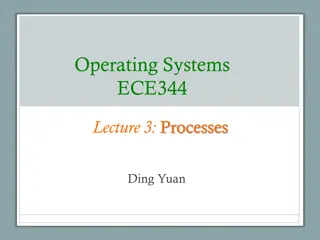
Torque Transmission by Keys and Forces Acting on Sunk Keys
Learn about different methods of torque transmission by keys, forces acting on sunk keys, and the design considerations for sunk keys. Explore how torque is transmitted through various key shapes and the forces involved in key fitting, torque generation, shearing, and compressive stresses. Understand the assumptions made during the design of sunk keys for optimal strength and performance.
Download Presentation

Please find below an Image/Link to download the presentation.
The content on the website is provided AS IS for your information and personal use only. It may not be sold, licensed, or shared on other websites without obtaining consent from the author. If you encounter any issues during the download, it is possible that the publisher has removed the file from their server.
You are allowed to download the files provided on this website for personal or commercial use, subject to the condition that they are used lawfully. All files are the property of their respective owners.
The content on the website is provided AS IS for your information and personal use only. It may not be sold, licensed, or shared on other websites without obtaining consent from the author.
E N D
Presentation Transcript
6. TORQUE TRANSMISSION BY KEYS According analysis, classified into four main groups. These included: 1. Rectangular fitted key in which the torque is transmitted by means of compressive stresses as Figure. to stress can b keys be F h/2 h F Mt and shown shear R in F = Mt / R Rectangular sides keys.
2. which transmitted by means of compressive stress alone as shown in Figure. Tangential the keys, torque in is h R F Mt F = Mt / R Tangential keys.
3. Tapered keys, in which the torque is transmitted by means induced by stress as Transmission due to frictional forces generated by taper sides keys. R of compressive in Figure. of torque friction F Mt p Transmission of torque due to frictional forces generated by taper sides keys.
R 4. Tapered keys fitted on the sides and round keys, in which transmitted simultaneous compressive stresses and shown in Figure. R F torque by action and friction is F the of Mt shear as R R F F Mt
7. FORCES ACTING ON SUNK KEYS L W L t F W F F << F t F F neglected F
Therefore, when shaft and hub, the following forces appear: A.Force F due to the fit of the key in its keyway (Compressive - difficult to determine in magnitude - small). key transmitted torque between F B. Forces generate transmitted torque. F = Torque /radius F that the F due to F F These forces produced shearing and compressive (crushing) stresses in the key.
8. STRENGTH OF SUNK KEY During the design of sunk key, the following assumptions should be taken into consideration: 1. The forces due to fit (F ) are small and negligible. 2. The forces are uniform distributed along the length of the key.
Let us consider the following; T : Torque transmitted by the system. F : Tangential force acting on the key at the circumference of the shaft. D :Diameter of the shaft. L : Length of the key. W : Width of the key. t : Thickness of the key. : Shear stress for the material of the key. : Compressive stress of the material of the key.
Now, considering shear of the key: The tangential circumference of the shaft can be computed as follows: shearing force acting on the F = Area resisting shearing x shear stress F = (L.w) i.e.; Torque transmitted = T F d W F T = = F t F 2 d = = T LW F 2
Considering, crushing of key, the tangential crushing force acting on the circumference of the shaft can be determined as follows: F = Crushing area x crushing stress t = = F L F 2 W F t F d t d = = = = T F L 2 2 2 F
Then, the key can be equally strong in both of shear and crushing, if : Crushing stress = Shear stress d t d = = L W L 2 2 2 It is important to notice that the permissible crushing stress for the usual key material is at least twice the permissible shear stress. i.e., = 2 Therefore, W = t
i.e. the square key is equally strong in shearing and crushing. To calculate the length of the key to transmit full power of the shaft, the shearing strength of the shaft is equal to the torsion shear strength of the shaft. The shear strength of the key is: d = = T L W ----------- (Equ. I) 2 And, the torsion shear strength of the shaft is: = = 3 T ' d ----------- (Equ. II) 16
where, : The shear strength of the key. : The shear strength of the shaft material. Equ. I = Equ. II , Therefore 2 8 ' d = = L --------- Equ. III W Take: W = d/4, then; ' --------- Equ. IV = = L 1 57 d .
Equation (IV) can be used to determine the key length. For special cases when the material of the shaft and key is similar, = = ' 2 d = = & L 8 W And, if w = d/4 then, = = = = L d 1 . 571 d 2
9. SOLVED PROBLEM A 20 h.p., 960 revolution per min. motor has a mild steel shaft of 40 mm diameter and extension being 75mm. The permissible shear and crushing stresses for the mild steel key are 560 kp/cm and 1120 kp/cm . Design the keyway in the motor shaft extension. Check the shear strength of the key against the normal strength of the shaft. Solution Given: P = 20 h . p. N = 960 r.p.m. D = 40 mm L = 75 mm all= 560 kp/cm2 all = 1120 kp/cm2
20 x 4500 = = = = T 14 92 . kp m . 2 x 960 = = 1492 kp cm . 1.Design of keyway d = = T L W 2
As the width of the keyway is too small, then, W should be 0.25 d i.e. W = d/4 = 4/4 = 1 cm = 10 mm Checking the shear strength of the key against the normal strength of the shaft Checking the shear strength of the key against the normal strength of the shaft
d LW Shear strength of the key 2 = = Normal strength of the shaft 3 ' d 16 LW 8 = = 3 d 8 x 7 . 5 x 3 1 = = x 4 = = 1 2 . Notice: The value of is twice .
10. EFFECT OF KEYWAYS Cutting of keyways in the shafts tends to reduce the load carrying capacity of the shaft due to the occurrence of the stress concentration. Therefore, a shaft strength factor experimental results which can be expressed as follows; is determined from W h = = e 1 0 2 . 1 1 . 1 d d
e is the ratio of the strength of the shaft with keyway to the strength of the same shaft without keyway. where: e W : Width of keyway. d : Shaft diameter. h : Depth of keyway. : Shaft strength factor. However, it is usually assumed that the strength of the keyed shaft is 75% that of the solid shaft without keyway, which is higher than the value obtained by the above relation.
E EN ND D






















